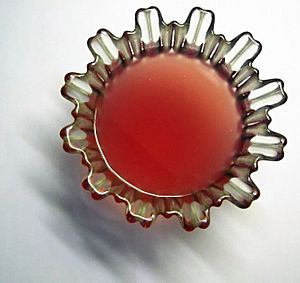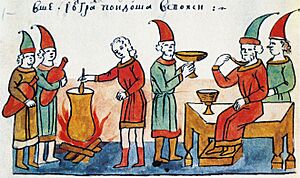Kissel facts for kids

Estonian red currant kissel
|
|
| Alternative names | Kisel |
|---|---|
| Type | jelly |
| Course | dessert or drink |
| Region or state | Central and Eastern Europe, Baltic states and Finland |
| Main ingredients | 1) fruit juice (or puree) or milk thickened with cornstarch or potato starch; 2) grain or oat flakes |
Kissel (also spelled kisel) is a yummy dish that can be a thick, jelly-like dessert or a refreshing drink. It's popular in countries like Poland, Russia, Ukraine, and Finland. You can enjoy kissel either warm or cold, depending on how it's made and what you like!
If kissel is made a bit thinner, it's often enjoyed as a drink. This is common in places like Poland, Belarus, Russia, and Ukraine. In Finland, this thinner version is called mehukeitto, which means "juice soup."
Contents
What is Grain Kissel?
The word "Kissel" comes from an old Slavic word meaning 'sour'. This is because the very first kissel was a sour porridge. It was made from grains like oats, but people also used other grains or even peas and lentils. These old grain kissels were not sweet like many modern versions.
One famous story about grain kissel comes from the 10th century. It's told in an old East Slavic book called the Primary Chronicle. In 997, a city called Belgorod Kievsky was under attack by a group called the Pechenegs. The people inside the city were running out of food.
An old man had a clever idea. He told everyone to make kissel from their last bits of grain. They also made a sweet drink from their last bit of mead (a honey drink). They dug holes in the ground and put containers of kissel and mead inside. Then, they built fake wells over them.
When the Pechenegs' leaders came to the city, they saw the people getting food from these "wells." The Pechenegs even got to taste the kissel and mead! They were so impressed that they thought the people were being mysteriously fed by the earth itself. Because of this trick, the Pechenegs gave up their attack and left the city.
Delicious Fruit Kissel
Fruit kissel is a thick, fruity dish that's popular as a dessert or drink. It's made from the sweet juice or mashed fruit of berries. It's similar to a fruit drink called mors, but it's much thicker. This thickness comes from adding cornstarch or potato starch. Sometimes, people also add red wine or fresh or dried fruits.
Fruit kissel is a bit like other European desserts, such as Danish rødgrød or German Rote Grütze. A Swedish dessert called blåbärssoppa is also made in a similar way using bilberries.
You can serve fruit kissel hot or cold. It's often enjoyed with sweetened quark (a type of soft cheese) or cream. Some people even put it on pancakes or with ice cream!
Popular Fruit Flavors
Today, many people in Poland use instant mixes to make fruit kissel. The most popular flavors there are strawberry, gooseberry, and raspberry. In Russia, people love cranberry, cherry, and redcurrant kissel.
In Lithuania, cranberry kissel (called spanguolių kisielius) is a special dish eaten on Kūčios, which is their Christmas Eve supper. In Finland, kissel is often made from bilberries. This is because bilberries grow wild in the forests, so they are easy to find and free! People also make kissel from prunes, apricots, and strawberries.
Different Thicknesses
The thickness of kissel depends on how much potato flour or starch is used. Thin kissel is easy to drink. Thicker versions are almost like jelly and are eaten with a spoon.
Rhubarb can also be used to make kissel, but it's often mixed with strawberries to make it sweeter. Kuningatarkiisseli (which means 'Queen's kissel' in Finnish) is made with a mix of berries and berry juices, usually bilberries and raspberries. Prune kissel (luumukiisseli in Finnish) is a traditional dish eaten with rice pudding at Christmas time.
-
Russian syrniki (cheese pancakes) served with kissel.
Milk Kissel
Milk kissel (called budyń or kisiel mleczny in Polish, and maitokiisseli in Finnish) is a creamy dessert. It's a bit like semolina pudding or a type of custard. It's made from milk and thickened with potato starch (in Poland) or corn starch (in Finland). It's usually flavored with sugar and vanillin (or vanilla) or cocoa powder. Sometimes, people add butter and egg yolks to make it even richer.
You can eat milk kissel by itself as a dessert. It's also delicious with fruit syrups, sauces, jams, fresh or dried fruit, or with cookies. It can even be used as a creamy filling for cakes, like for a karpatka or napoleonka cake. Just like fruit kissel, many Polish families now use instant mixes to make milk kissel.
See also










